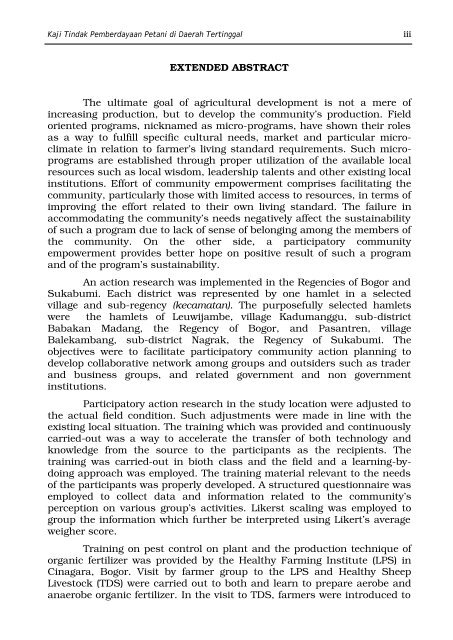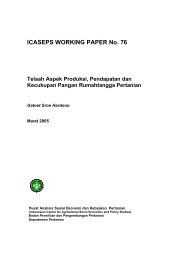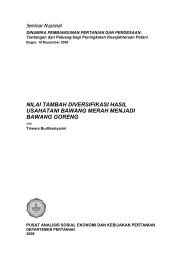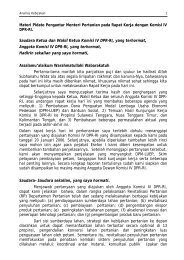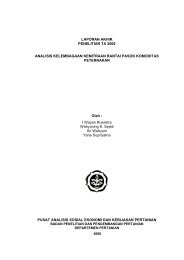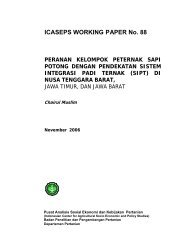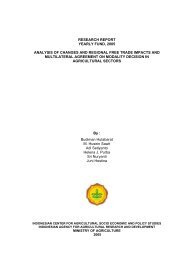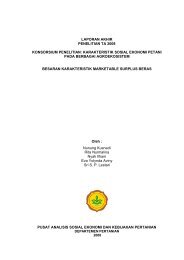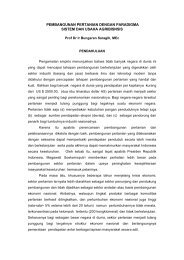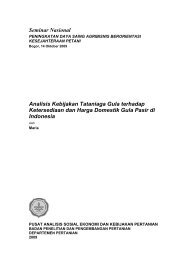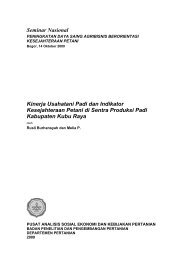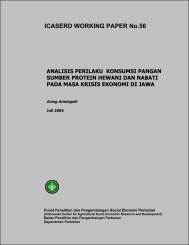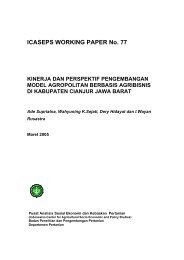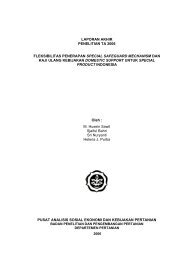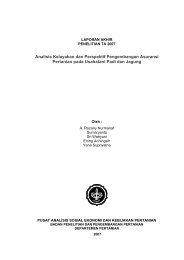pemberdayaan masyarakat pertanian daerah tertinggal
pemberdayaan masyarakat pertanian daerah tertinggal
pemberdayaan masyarakat pertanian daerah tertinggal
Create successful ePaper yourself
Turn your PDF publications into a flip-book with our unique Google optimized e-Paper software.
Kaji Tindak Pemberdayaan Petani di Daerah Tertinggal<br />
iii<br />
EXTENDED ABSTRACT<br />
The ultimate goal of agricultural development is not a mere of<br />
increasing production, but to develop the community’s production. Field<br />
oriented programs, nicknamed as micro-programs, have shown their roles<br />
as a way to fulfill specific cultural needs, market and particular microclimate<br />
in relation to farmer’s living standard requirements. Such microprograms<br />
are established through proper utilization of the available local<br />
resources such as local wisdom, leadership talents and other existing local<br />
institutions. Effort of community empowerment comprises facilitating the<br />
community, particularly those with limited access to resources, in terms of<br />
improving the effort related to their own living standard. The failure in<br />
accommodating the community’s needs negatively affect the sustainability<br />
of such a program due to lack of sense of belonging among the members of<br />
the community. On the other side, a participatory community<br />
empowerment provides better hope on positive result of such a program<br />
and of the program’s sustainability.<br />
An action research was implemented in the Regencies of Bogor and<br />
Sukabumi. Each district was represented by one hamlet in a selected<br />
village and sub-regency (kecamatan). The purposefully selected hamlets<br />
were the hamlets of Leuwijambe, village Kadumanggu, sub-district<br />
Babakan Madang, the Regency of Bogor, and Pasantren, village<br />
Balekambang, sub-district Nagrak, the Regency of Sukabumi. The<br />
objectives were to facilitate participatory community action planning to<br />
develop collaborative network among groups and outsiders such as trader<br />
and business groups, and related government and non government<br />
institutions.<br />
Participatory action research in the study location were adjusted to<br />
the actual field condition. Such adjustments were made in line with the<br />
existing local situation. The training which was provided and continuously<br />
carried-out was a way to accelerate the transfer of both technology and<br />
knowledge from the source to the participants as the recipients. The<br />
training was carried-out in bioth class and the field and a learning-bydoing<br />
approach was employed. The training material relevant to the needs<br />
of the participants was properly developed. A structured questionnaire was<br />
employed to collect data and information related to the community’s<br />
perception on various group’s activities. Likerst scaling was employed to<br />
group the information which further be interpreted using Likert’s average<br />
weigher score.<br />
Training on pest control on plant and the production technique of<br />
organic fertilizer was provided by the Healthy Farming Institute (LPS) in<br />
Cinagara, Bogor. Visit by farmer group to the LPS and Healthy Sheep<br />
Livestock (TDS) were carried out to both and learn to prepare aerobe and<br />
anaerobe organic fertilizer. In the visit to TDS, farmers were introduced to


